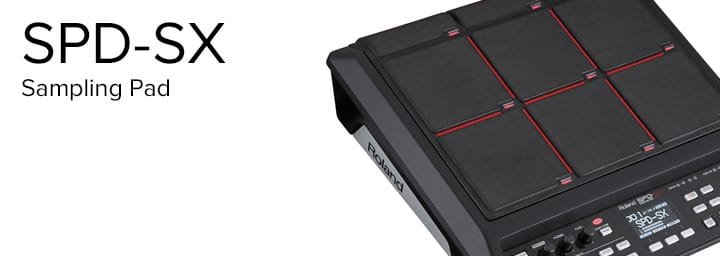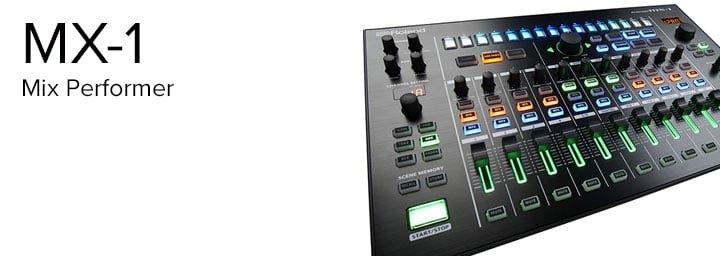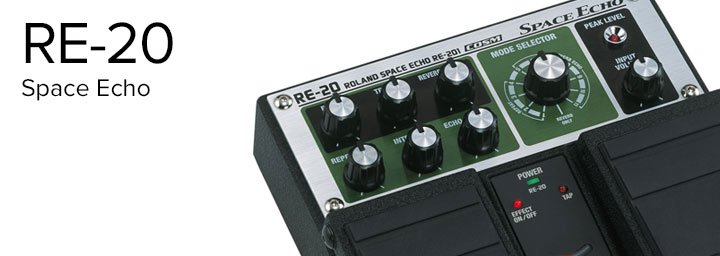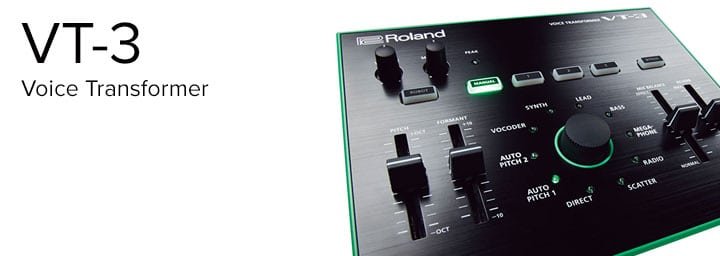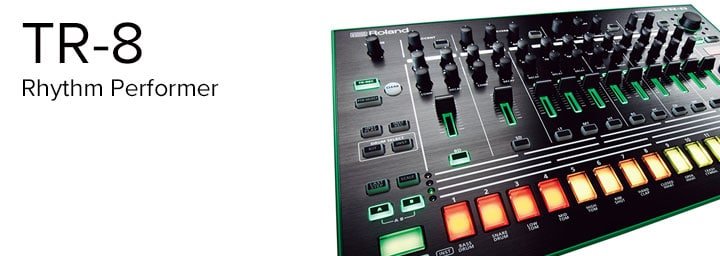SBTRKT (AKA Aaron Jerome) is undoubtedly one of the hottest producers around. DJ, remixer and studio alchemist, SBTRKT won hearts and minds with his eponymous debut album back in 2011, which led him to collaborate with Radiohead, M.I.A., Mark Ronson and Modeselektor to name just a few. Building on the huge success of his debut, last year saw SBTRKT release the hotly-anticipated follow-up album, Wonder Where We Land, which sees him explore even more exotic soundscapes and studio techniques.
An enthusiastic exponent of Roland gear past and present, we couldn’t pass up the opportunity to hook up with SBTRKT before his blistering appearance at Stockholm’s famed Sonar Festival to find out more about the musician behind the mask…and to introduce him to the rather fine AIRA MX-1…well, it seemed only polite, really!
Contributed by Roland UK
You have a bit of history with Roland gear. Can you tell us a little about what you’ve used and how you’ve used it over the years?
I guess I started off making music mainly on laptops, sort of the late 90s and into the 2000s. I learned about the Roland gear through reading magazines and also understanding what sort of gear classic albums I really liked were made with. Daft Punk was my first musical love and at that point, I never knew any of the gear they used to make those records. It was only years later I actually knew what the construct was and worked out they were 808’s and 909’s. I suppose that was the period where analog gear became my new fascination beyond laptops and, not even laptops, but desktop computers at home.
The first vintage synth I bought was a Juno-106. That was the point where I was just really interested in trying to work outside the box. It’s splattered all over my first album. That was the main synth I used. There’s a track called Ready Set Loop, which is essentially just the Juno on its own. Every sound on that song comes off one synthesizer. It was sort of a revelation where I realized there was a big difference between a plug-in and a real analog instrument. That was the start of the collection, I suppose.
So, what did you add to the collection next?
I bought an RE-20 Space Echo pedal. At that point, I couldn’t afford a real one, and that was really cool. I used it in lots of different ways. It was great as an effect on synthesizers, on vocals and then eventually I started using it on a Theremin on my first album live show and then also on a TR-707. I bought the 707 while on tour as I was getting fed up with using Ableton drum sounds or, like, remade versions of a 707.
That was the first time I’d done anything with a classic Roland drum machine as well. It was really temperamental at the time. Being able to use a 1980s bit of gear on stage in the present day when everything else is very synced up and clocked, and trying to work with the nuances of it where it might switch itself off and you have to try and get the timing back in manually. It was a lot of fun though, and there was that warmth and distortion that you get when you just whack all the levels up, which was amazing, you know, that kind of sound.
We know that you’ve got some drum stuff as well, SPD-SX and some pads?
Yeah, exactly. And then in-between, I’ve got an SH-101, which has been a really key thing for me on both albums I’ve written. I’ve always used that as my mainstay for bass sounds. My favourite thing about it is the arpeggio mode and the step sequencer. I was showing that off to a friend of mine the other day, just going ‘Have you ever seen an SH-101 where you can just literally write in the notes?’ Roland gear has just been with me all the way through. I’ve used it in the studio and integrated into the live show, because those pieces have always been very easy to manipulate in a live scenario. They kind of live in their own world.
Add on to that, as you just mentioned, the SPD’s. The first thing I started off with was the SPD-20 Octapad with the built-in sounds. It had a built-in, recordable step sequencer in it and I used to use the clock source from Ableton, but standalone and be able to play in melodies as well as triggers from my live drum kit. So it had sort of a double purpose at the time or even a three-way role, as I was also using it as a MIDI controller for sounds from Ableton Drum Rack. I was trying to make people see there was so much coming from different directions. It was getting confusing for me, but I was also using things in more than the way they were traditionally made for.
Now I’ve expanded that. For this live show, I’ve moved away from playing drums and I’m playing synthesizers, keyboards and other effects and bits of hardware. I have a secondary percussion and synth player, and also a dedicated drummer, so both of them use SPD’s to control and sample effects from all parts of songs. It’s primarily musical sounds, like bass sounds and percussive bits. The other one on the drum kit is primarily stuff with triggers from the bass and snare, and incidental vocal sounds as well.
Is that the set-up you’re using to tour the recent album?
When I started touring Wonder Where We Land in May 2014, it was at the time Roland introduced the TR-8. I was always fascinated by the idea of using 808 sounds, especially on my second album as I got quite influenced by genres which were really prevalent at the time. Look Away on the album is one track which heavily uses 808 pattern kicks, like hi-hats and kicks. It’s just played in live and I played that off a Roland kit using MIDI triggers to sound modules.
Basically, I was just playing it completely live, but when it comes to a live show, I wanted to be able to replicate that. That was the perfect way of being able to take out my 707, which was a little bit temperamental, and put in a piece of gear that was more multi-purpose, that had built-in effects and could do other things and be able to manipulate each of those sounds.
So, are you using the 909 sounds on it as well as the 808 ones?
I do actually use both. I sort of flit between them in different songs. So like, on New Dorp. New York, I use a different kick like the 909, compared to Look Away or War Drums where I’ll use an 808. I’m very used to tweaking the compression and the tuning of notes live in the show, so if I want something with, say, an open hi-hat tone. It becomes very obvious in the environments I play in for live shows. The tuning of a bass drum when you have a live drummer next to you who’s already playing a kick drum, and you need to be able to duplicate, but also build a different pitch around that, being able to use the tuning on the TR-8 has become really useful.
I suppose the effect I use most is mainly reverb, just putting it across all the sets. The delay function I also find really useful to just build up a little more atmosphere, so it’s not quite as dry when sending out the signal. But, yeah, for me, it’s become a really useful tool across the board to be able to add in that lower end and also the percussive part as well. I use the high toms and the rim shots a lot through my live shows.
We believe you’ve also just got yourself the VT-3 Vocal Processor?
Yeah, up to this point I’ve sort of experimented with vocal transforming sounds like using pitch shift vocals and affected things, and I’ve used different tools for that, whether it was effects processors or computer-based effects to do that before. They can be great on one part but they’re often not very controllable on stage. They’re not easy to use, so the VT-3 has been a really cool way to bring in a tool which any person could learn in two minutes. To be able to go, look, if you wanna add reverb, if you wanna change it, we can do these presets.
Like, New Dorp. New York is one which has an octave pitch down vocal sitting on the track, so to have a tool immediately there where I can dial up that effect without having three different bits of gear to try and pitch a vocal live, and having all of these fragments of the sound where it doesn’t sound true to the original sound is brilliant. The processing in it is really true to the character of the voice too – if you want it to be, cos obviously the robot function is really cool too.
So, we’re here at Sonar, you’re about to play in Stockholm and you played Iceland last night. We brought some new gear to show you – we know you’ve seen the videos for the MX-1 but as the first person to actually see this as an artist what were your initial thoughts?
I’m just really excited by the way these tools integrate. From using the AIRA TR-8 and the VT-3, I suppose I’ve always looked for ways of expanding upon it and I come very much from an angle where the live performance element is really key to my shows, you know? The bits where it’s not so much just letting things run and doing small manipulations of it, and my shows aren’t very pattern based either, but I like the idea of being able to send out a lot of channels to my front of house engineer but also being able to micro-mix parts of that as well.
Also, being able to send out elements which I have more control over, so that’s the tone and the filters, and to be able to add effects on a bunch of different channels together. There are just so many options, which I’ll be able to explore with this tool – whether it’s combining the Roland gear I already have or other elements of synthesizers I use on stage, other analog synths which I can then effect within one interface, which at the moment I haven’t got. If I wanna high-pass filter a bunch of gear I have to go to all those dedicated machines, or if I wanna put a delay on I have to go to each of those individually. To be able to do that from one interface will be really great for me.
Being able to use both the main mixes, the auxiliary mixes, being able to queue those effects…kind of sounds like I’m trying to sell it but, for me, I love tools which don’t seem to box in the possibilities too quickly. This MX-1 is the one device I’ve seen recently which just seems to not restrain you. It’s not just going, ‘Well, it sends the clock source’. It seems to do so many things.
If you wanna use it as a hub controller for your computer or if you want to be able to put all the audio through one device, just want to sequence or sync things, or just control different elements of it, it’s all there and that, for me, is really interesting. That possibility of taking something on stage and being able to process it in the way your mind thinks you want to, on the spot, without having to go, well, I need five different devices just to do that usually!
Absolutely, just making it as easy as possible for you because you’ve got a lot going on up there when you’re playing live?
Yeah, and I find the way it’s laid out seems quite simplified in approach. It’s not hard to get your head around the idea and once you’ve got the basics of step sequencing, having dedicated mutes and volume controls, and the way the light works to kind of show you what is going on onstage. That’s definitely been an issue.
I remember when I started out I was finding gear which didn’t have any light on it at all – even some of the older Roland gear like the 707 didn’t have a light-up screen, so in a show we had no clue what it was doing. You’re doing everything by ear, which is great to some extent, but when you’re doing something which is mix-based, I think having light is really key to that as well. One thing is, I like my shows to be quite dimly lit so it’s more about the music than it is about the jumping around performance of it, so, for me, having that gear which is lit up means I don’t have to completely over-light the stage just to be able to see things.
Good to hear your enthusiasm for the new gear. Going off on a tangent now, if you had a day off tomorrow and could do a track with anyone at all, who would it be?
That’s always a hard one. For me, I like to work with people who have very different skill sets to me. I’m a massive fan of Kendrick Lamar and I imagine working with someone like him would teach me something completely different. For me, my favourite thing, which I suppose sort of explains my albums and stuff, is finding things which don’t necessarily add up to other people, y’know? Collaborations which don’t really seem to sit quite right. It’s just music that I love, and then things that I have a hunch that I could work with someone and create something unique there, something which is these two worlds colliding.
On the plane on the way out here, I read an interview with you where they were talking in a complimentary way about how your track, New Dorp, was probably one of the weirdest singles. The way that it starts off with that amazing bass line but then it doesn’t go as commercial as maybe people think it might…
I just don’t have any way of knowing what I kind of create in the studio. I don’t have any set rules, I don’t have, like, a template format for writing music. When I work with one collaborator, it’s just gonna be what we create in that moment. The one thing is working with the collaborators I do, like with Ezra on that track, it’s a one-on-one process. We don’t have other songwriters involved. There are no other people dictating to us. We don’t have a record label saying, “Well, you’ve got to create this into something more, you need a bigger hook or something else”. Very much it’s just what I’ve done in that moment.
Jamie XX said in his interview that when he went to the States and did the thing with Drake, it was nice to get input, but he doesn’t need twenty people telling him how to make a hit record.
Yeah, exactly, and I think any artist I love generally has that kind of approach anyway. They’ve got their own free will and power to do what they love in music. Contemporaries like Caribou, Flying Lotus, Little Dragon – these are all acts who I really respect because of their ideals and the way they create music. And also, they’re all acts who blur the lines between what they do in the studio and live performance as well, two different and intriguing worlds.
Could you give the Roland community any tips on how to produce unique music?
The way I started out was very much learning from my peers or the people I respected as artists. That was my first step. If I could create something like another artist then that would give me the knowledge to go beyond that. I think if you learn the most about all the things you love in music and learning everything about them, then tearing that rule book up, and starting from scratch and taking unique parts from all those little worlds and different influences.
If you only know about them but can’t create them, that’s a very different thing. If you sit at an analog synthesizer and you learn all of its functions and you know how to create the difference between a nice, surreal pad and a crunchy bassline, with a few turns of a few knobs, then you’re gonna be able to create any world you can imagine. It’s very much your own ears and the way you approach that. Every person I’ve ever worked with, or artists I’ve ever met, has always got a unique way of being able to dial in a sound, y’know?
And what I love, even when they come to my studio, is throwing people in front of a synthesizer and seeing what they come up with and generally every person… even in my live show when I have another collaborator who’s on stage with me, they’ll dial in a very different patch when there’s no presets. It’s always really cool and unique. That, for me, is kind of key. I’m not a purist, I suppose, in saying about types of gear that you have to have lots of hardware and you’ve got to have analog stuff, I love the hybrid of everything.
I would say 90% of my time is sitting in front of a sequencer basically, but with lots of synthesizer and other parts around. That hybrid, for me, of audio and MIDI and being able to mix between the two, whether its plug-ins or bits of live percussion or microphone stuff or recordings, it’s everything. And it’s not settling too close to a genre. I like the idea of experimentation. Today we can go and paint a completely different picture to what I did yesterday, not just saying I’m safely going to follow the same path and a formula.
Arthur Baker’s interviewed a lot of people for the 808 movie – what do you think it is about the 808 that spawned such an incredible legacy?
For me, it’s just the way that it seems to fit in any space without needing a lot of other textures there. Even if you don’t put any other sound within a realm. Whether that’s the sparsest hip-hop track or a techno record, you don’t need a huge amount of other detail to automatically feel like you’ve filled out the mix, because just a kick drum will fill out a lot of that sound and sonic area.
It’s instantly recognisable?
Yeah. And the same with the tightness of the hi-hats and the percussive sounds. There are myriad genres which all feel completely different, just because that kit can be manipulated in so many different ways. Another thing is that it doesn’t sound traditional, and a lot of other drum sounds are still very much about trying to emulate something which is in real life but then also, it’s just such a familiar kit these days, it’s used on everything, isn’t it? Especially in the last two years, even more so. I don’t think there’s a hip hop record out there that doesn’t use an 808.
We were listening to some DJs last night and you could just hear it. You’re like, that’s the 808…
The first artist… I was in the hotel earlier which is… annoyingly for me, my room is right next door to the room I’m playing in at the venue, which is the strangest thing and the first artist came on at nine o’clock and immediately there was an 808…
Keep it down, I’m trying to sleep in here…!
I could hear it clearly, it was like an 808 pattern suddenly just came in and it wasn’t techno or anything, it was just some sort of slow hip-hop thing, and it’s really interesting to see how prevalent it is in different genres and different spaces.
I can imagine it’s quite unforgiving if you’re trying to sleep…
I’m not dissuaded of using it because of its popularity, I generally like to use it in different spaces and if it fits in a different genre, in a different way, then that’s cool with me and I’m pretty sure it still has life. In ten or fifteen years there’ll still be new ways of using it. For me, it’s now using those kits and seeing if I can effect it even further, take those sounds and tune them and do more with that, even externally from those drum sounds and stuff.
Your last record, the theme was mystical animals so I Googled a couple on the plane and found one called Abaasy, which is a mystical demon with teeth of iron. Heard of that one?
No, never heard of that one…
There’s one called Abaia, which is a huge magical eel from Greek times. And then the last one is a Pollo Maligno, a Columbian creature which apparently is a man-eating chicken spirit. I thought you might like them, maybe give you some inspiration.
I loved that time when things weren’t easily Google-able. When people’s imaginations could run away, cos there was no proof of the existence of things. That sort of works its way into music as well, I suppose. The idea that you believe anything you want to about something. If you just listen to it in its essence, you’ll project your own thoughts and lifestyle and whatever, your other thinking about how that works for you, or your own storylines onto it.
That ethos helped you design the cover?
I work with someone who does all the artwork, yeah. We’ve collaborated since I started out from the mask, to the albums, to the live show, to everything, so we collaborate on those elements. We build a story all the way through, even to what we’re working on now for the new releases coming out this year.
Very last question, promise, as I know you’ve got to eat before you play. So, we’re in Sweden, obviously there’s a certain scene in every country, but what do you think Sweden has going on?
I’ve played here a bunch of times, and you get invited to play festivals. It was really funny, cos we came back to the airport and there’s this jumbo jet plane which is a hotel outside Stockholm airport and I was like, “I’ve seen that”. I thought it was in Norway and then I realised it was here, and I’ve been here before about two years ago.
And there’s a boat hostel as well. Did you see that?
No, no. But generally Sweden’s got so many acts. Like The Knife, they’re one of my favourite all-time bands. And Little Dragon, obviously, are a key collaborator of mine, and they’ve definitely always repped Sweden. For me, it’s been the kind of quintessential sound. Festivals are quite different, because generally they’re importing music to a country rather than giving lots of Swedish music, but, it’s being able to go and play to different audiences in different places and seeing how they react to different songs, and seeing which ones are received better.
Whether they’re more into some of the more ambient bits or they’re really into, like, Wild Fire or New Dorp or other things, different places always react differently, which I find really refreshing. It means there’s not one sound or one track that’s the thing they all gravitate towards. Wild Fire for me is one of those lynchpin things which around the world people gravitate towards if I play it, and they’ll all go kinda crazy. But, there are other songs in the mix and it always differentiates. Different places will go mad for a different song.
Wonder Where We Land is out now on Young Turks
Related Articles
MASSIVE ATTACK IN THE STUDIO WITH ROLAND AIRA
ROLAND ARTIST INTERVIEW – UNDERWORLD
THE ULTIMATE GUIDE TO THE AIRA MX-1
THE ULTIMATE GUIDE TO THE AIRA TR-8 RHYTHM PERFORMER
ROLAND ICON SERIES: THE JUNO-106 SYNTHESIZER
ROLAND ICON SERIES: THE SH-101 SYNTHESIZER

